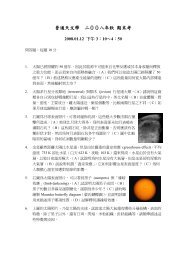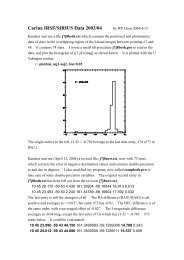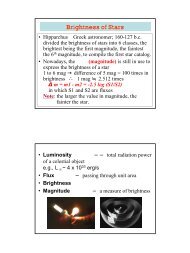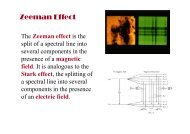Hayashi Track
Hayashi Track
Hayashi Track
You also want an ePaper? Increase the reach of your titles
YUMPU automatically turns print PDFs into web optimized ePapers that Google loves.
Stellar Structure
Structure Equations<br />
What do these equations mean
Hydrostatic equilibrium<br />
Equation of state<br />
Mass continuity (distribution)<br />
Opacity<br />
Energy generation<br />
Energy transport<br />
Nuclear reaction rate<br />
by radiation<br />
by convection
Variables (7): m, ρ, T, P, κ, L, and q<br />
Vogt-Russell theorem<br />
In general<br />
Mean molecular weight<br />
μ = 1/2 (H)<br />
= 4/3 (He)<br />
2 (metals)
At the center of a star in hydrostatic equilibrium<br />
Integrating from the center to the surface<br />
With the boundary conditions,<br />
Thus,
Luminosity<br />
Ohm’s law<br />
in circuit I = V / R<br />
[flow] [pressure gradient] / [resistance]<br />
Pressure = [energy] / [volume]<br />
Blackbody radiation<br />
Energy density u = aT 4<br />
Radiation pressure P = (1/3) u
T » ¹ GM<br />
R
Opacity<br />
• Bound-bound absorption Excitation of an electron of an atom<br />
to a higher energy state by the absorption of a photon. The<br />
excited atom then will be de-excited spontaneously, emitting a<br />
photon, or by collision with another particle.<br />
• Bound-free absorption Photoionization of an electron from an<br />
atom (ion) by the absorption of a photon. The inverse process is<br />
radiative recombination.<br />
• Free-free absorption Transition of a free electron to a higher<br />
energy state, via interaction of a nucleus or ion, by the absorption<br />
of a photon. The inverse process is bremsstrahlung.<br />
• Electron scattering Scattering of a photon by a free electron,<br />
also known as Thomson (common in stellar interior) or Compton<br />
(if relativistic) scattering.<br />
• H − absorption Important when < 10 4 K, i.e., dominant in the<br />
outer layer of low-mass stars (the Sun)
• Bound-bound, bound-free, and free-free<br />
opacities are collectively called Kramers<br />
opacity, named after the Dutch physicist H. A.<br />
Kramers (1894-1952).<br />
• All have similar dependence T −3.5 .<br />
• Kramers opacity is the main source of opacity<br />
in gases of temperature 10 4 -10 6 K, i.e., in the<br />
interior of stars up to ~ 1 M ⊙.<br />
• In a star much more massive, the electron<br />
scattering process dominates the opacity, and<br />
the Kramers opacity is important only in the<br />
surface layer.
Data from Iglesias & Rogers (1996)<br />
X=0.70<br />
Z=0.02
Opacity
Main sequence = a mass sequence defined by hydrogen<br />
fusion at the center of a star<br />
Radius does not vary much; but the luminosity does.<br />
log L ∝ log T
T c<br />
≈<br />
μ M<br />
R<br />
So for a given T c , M → R<br />
→ L<br />
L (∝ R 2 T 4 ) and T<br />
Main sequence is a run of L and T c as a function<br />
of stellar mass, with T c nearly constant.<br />
Why T c ≈ constant<br />
Because H buring at ~10 7 K
c P − c V = k B<br />
c P / c V = γ<br />
Heat capacity: heat<br />
supplied to increase one<br />
degree in temperature
Convective stability/instability<br />
• A fluid to resist vertical motion
Convective stability: a fluid to<br />
resist vertical motion<br />
Vertical perturbation<br />
dampens out
= surrounding<br />
temperature gradient
For a very low-mass star, ionization of H and He<br />
leads to a fully convective star H completely<br />
burns off.<br />
For a sun-like star, ionization of H and He, and<br />
also the large opacity of H ─ ions a convective<br />
envelope (outer 30% radius).<br />
For a massive star, the core produces fierce<br />
amount of energy convective core<br />
a large fraction of material to take part in the<br />
thermonuclear reactions
A binary system at 5.74 pc. Gliese 752A (=Wolf 1055) is an M2.5 red dwarf (mass ~0.46<br />
solar, m V ~9.13), whereas Gliese 752B (VB 10) is an M8V (mass ~0.075 solar, m V ~17.30).
A convection<br />
evolutionary track<br />
for low-mass premain<br />
sequence stars<br />
<strong>Hayashi</strong> <strong>Track</strong>
When a protostar reaches hydrostatic equilibrium,<br />
there is a minimum effective temperature (~4000<br />
K) cooler than which (the <strong>Hayashi</strong> boundary) a<br />
stable configuration is not possible (Chushiro<br />
<strong>Hayashi</strong> 1961).<br />
A protostar<br />
contracts on the Kevin-Helmholtz timescale<br />
is cool and highly opaque fully convective<br />
homogenizes the composition<br />
A star < 0.5 M ⊙ remains on the <strong>Hayashi</strong> track<br />
throughout the entire PMS phase.
Chushiro HAYASHI<br />
1920-2010
Radiative<br />
Convective<br />
Check out http://www.peripatus.gen.nz/Astronomy/HerRusDia.html for a good summary
Read this paper!
Convection<br />
Nuclear<br />
Reactions
Pre-Main Sequence Evolutionary <strong>Track</strong>s<br />
Stellar mass<br />
Stellar age<br />
(isochrones)<br />
http://en.wikipedia.org/wiki/File:PMS_evolution_tracks.svg
Protostars are heavily embedded in clouds.<br />
Birthline=beginning of PMS; star becomes<br />
optically visible<br />
Stahler (1983, 1988),<br />
Palla & Stahler (1990)
… compared with observations
Theoretical evolutionary tracks
1965ApJ...141..993
Effects of chemical<br />
abundances (“metals”)<br />
in determination of<br />
stellar structure.<br />
X M =5.4 x 10 -6<br />
X M =5.4 x 10 -5



![arXiv:0802.0303v1 [astro-ph] 4 Feb 2008](https://img.yumpu.com/51172811/1/190x245/arxiv08020303v1-astro-ph-4-feb-2008.jpg?quality=85)









